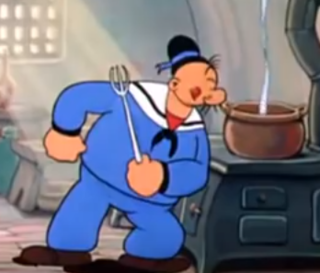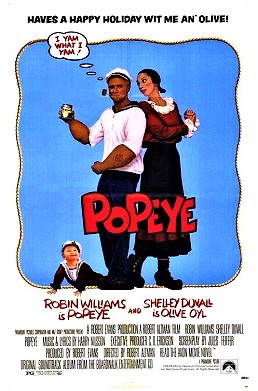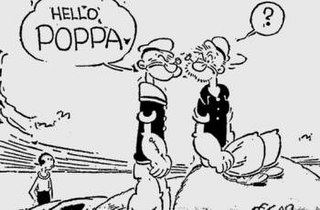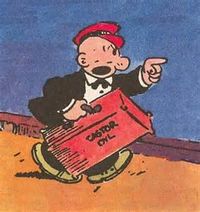
Olive Oyl is a cartoon character created by E. C. Segar in 1919 for his comic strip Thimble Theatre. The strip was later renamed Popeye after the sailor character that became the most popular member of the cast; however, Olive Oyl was a main character for a decade before Popeye's 1929 appearance.

J. Wellington Wimpy, generally referred to as Wimpy, is one of the characters in the comic strip Popeye, created by E. C. Segar and originally called Thimble Theatre, and in the Popeye cartoons based upon the strip. Wimpy debuted in the strip in 1931 and was one of the dominant characters in the newspaper strip, but when Popeye was adapted as an animated cartoon series by Fleischer Studios, Wimpy became a minor character; Dave Fleischer said that the character in the original Segar strip was "too smart" to be used in the film cartoon adaptations. Wimpy appears in Robert Altman's 1980 live-action musical film Popeye, played by Paul Dooley.

Elzie Crisler Segar, known by the pen name E. C. Segar, was an American cartoonist best known as the creator of Popeye, a pop culture character who first appeared in 1929 in Segar's comic strip Thimble Theatre.
See also: 1920s in comics, other events of the 1930s, 1940s in comics and the list of years in comics

Popeye is a 1980 American musical comedy film directed by Robert Altman and produced by Paramount Pictures and Walt Disney Productions. It is based on E. C. Segar's Popeye comics character. The script was written by Jules Feiffer, and stars Robin Williams as Popeye the Sailor Man and Shelley Duvall as Olive Oyl. Its story follows Popeye's adventures as he arrives in the town of Sweethaven.

Popeye's Voyage: The Quest for Pappy is a 2004 animated Christmas television special produced by Mainframe Entertainment for Lions Gate Entertainment and King Features Entertainment, in association with Nuance Productions. The special, created to coincide with the 75th anniversary of the Popeye the Sailor comic strip character from E. C. Segar's Thimble Theatre, first aired on Fox on December 17, 2004, and was rebroadcast on the same network on December 30, 2005.

Poopdeck Pappy is a fictional character featured in the Popeye comic strip and animated cartoon spinoffs. Created by E. C. Segar in 1936, the character is Popeye's father, who is between the ages of 85 and 99.
Swee'Pea is a character in E. C. Segar's comic strip Thimble Theatre / Popeye and in the cartoon series derived from it. His name refers to the flower known as the sweet pea. Before his addition to the animated shorts, the name "Sweet Pea" was a term of affection used by main character Popeye. In the cartoon We Aim to Please, he addressed girlfriend Olive Oyl that way.
Alice the Goon is a fictional character in E. C. Segar's comic strip Thimble Theatre and in the Popeye cartoon series derived from it.

I Yam What I Yam is the second Popeye theatrical cartoon short, starring William "Billy" Costello as Popeye, Bonnie Poe as Olive Oyl and Charles Lawrence as Wimpy. The source of the quote is the comic strip, Thimble Theatre by E. C. Segar, in which Popeye first appeared. This is a paraphrase of words spoken by Popeye in the comic strip.
This is a timeline of significant events in comics in the 1920s.

The All New Popeye Hour is an American animated television series produced by Hanna-Barbera Productions and King Features Entertainment. Starring the comic strip character Popeye, the series aired from 1978 to 1983 Saturday mornings on CBS. Despite the series' mixed reception, it was a hit for King Features Entertainment.

Harold Hamgravy, better known as Ham Gravy, is an American comics character from the Thimble Theatre series, created in 1919 by E. C. Segar.
George W. Geezil, also known as simply Geezil, is a comic strip character created by E. C. Segar for his strip Thimble Theatre in 1932.

Popeye the Sailor is an American animated series of short films based on the Popeye comic strip character created by E. C. Segar. In 1933, Max and Dave Fleischer's Fleischer Studios, based in New York City, adapted Segar's characters into a series of theatrical cartoon shorts for Paramount Pictures. The plotlines in the animated cartoons tended to be simpler than those presented in the comic strips, and the characters slightly different. A villain, usually Bluto, makes a move on Popeye's "sweetie", Olive Oyl. The villain clobbers Popeye until he eats spinach, giving him superhuman strength. Thus empowered, Popeye makes short work of the villain.

The Sea Hag is a fictional character owned by King Features Syndicate. She is a tall, masculine-looking witch featured in comics/cartoons as a nemesis to the character Popeye. The Sea Hag was created by Elzie Crisler Segar in 1929 as part of the Thimble Theatre comic strip.

Popeye the Sailor is a fictional cartoon character created by Elzie Crisler Segar. The character first appeared on January 17, 1929, in the daily King Features comic strip Thimble Theatre. The strip was in its tenth year when Popeye made his debut, but the one-eyed sailor quickly became the lead character, and Thimble Theatre became one of King Features' most popular properties during the 1930s. Following Segar's death in 1938, Thimble Theatre was continued by several writers and artists, most notably Segar's assistant Bud Sagendorf. The strip continues to appear in first-run installments on Sundays, written and drawn by R. K. Milholland. The daily strips are reprints of old Sagendorf stories.
Notable events of 1933 in comics.

Bela P. Zaboly, a.k.a. Bill Zaboly, was a first-generation Hungarian-American cartoonist best known for his work as the sole illustrator for the daily and weekly strips of Thimble Theatre’sPopeye from 1939 to 1959. He worked with two writers over this two-decade run leading the strip. Zaboly's well-known and distinctively illustrated signature used the initials BZ with the "B" formed by the wings of a bumblebee. In headings for Thimble Theatre, his typeset credit line often used his Americanized name, Bill Zaboly rather than his Hungarian given name, Bela Zaboly.

Charles H. Winner, better known as Doc Winner, was an American cartoonist, notable for his comic strips Tubby and Elmer, plus his contributions to Thimble Theatre, Barney Google and other King Features strips.














